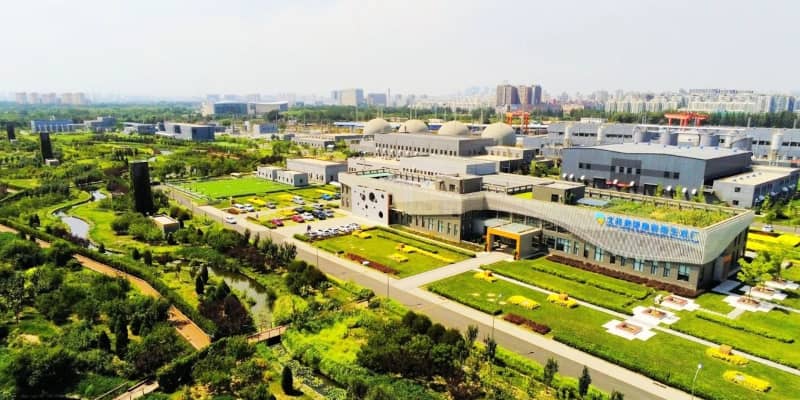How to tackle water scarcity in a city of 22 million people
Beijing Drainage Group is using water reuse, digital solutions and bold innovation to solve some of the toughest urban water challenges of our time.
Urbanization. Industrialization. Pollution. High population density. Limited freshwater supplies. Severe drought and flooding. China’s complex water issues have made water scarcity an urgent problem, especially in the capital city of Beijing where the population has grown from 5 million to nearly 22 million people over the past four decades.
To address the country’s water threats, policymakers and water operators are taking bold steps to transform how water is supplied and managed. One example is China’s increasing focus on water recycling. Four years ago, policymakers set a target for water-scarce cities to use recycled water to meet at least 25% of their water needs by 2025. In the Beijing-Tianjin-Hebei region, cities must increase their reuse utilization rate to more than 35%.
Making Waves spoke with Bing Liu, Sales GM of Xylem’s Water Infrastructure business in China, about the country’s growing water reuse opportunity and one utility leader that is leading the way: Beijing Drainage Group.
Q: What role does reclaimed water play in modern urban development in China?
A: Water reuse plays a fundamental part in forward-thinking urban development in China. Reuse offers the opportunity to significantly increase clean water supply while also protecting urban ecosystems.
By investing in modern, centralized wastewater treatment and recycling solutions, government and urban water operators are developing more effective ways to handle treated water that was previously released into local waterways.
Recycled wastewater becomes an asset, benefiting communities in multiple ways. It replenishes local rivers and lakes, irrigates parks and urban greenway projects, cleans roads and supports firefighting efforts. The high-tech sector and other industries also utilize reclaimed non-potable water to ease the demand on municipal supplies. As a result, more precious water is available for water-scarce cities and communities.
Q: Who is setting the standard in large-scale wastewater treatment and water recycling in China?
A: One standout leader is Beijing Drainage Group (BDG), which operates 17 reclaimed water plants and serves more than 17 million people across the capital city. The utility is considered a global trailblazer in wastewater treatment and water reuse practices.

BDG runs the world’s largest water reclamation system, recycling more than 5 million tons of wastewater a day.
The crown jewel of the system is the Huaifang Underground Water Reclamation Plant, the largest of its kind in Asia and a model for innovation.
BDG is considered a pacesetter for more than just its ability to operate on a large scale; the utility is also an early adopter of digital water solutions across the wastewater cycle. BDG began implementing a digital action plan for its sewage treatment plants in 2019 and has gone on to create digital platforms to manage everything from chemical dosing for water treatment to flood prevention.
Q: What are some of BDG’s biggest water reuse success stories, and how is the utility optimizing its facilities?
A: BDG is setting the pace for how cities can use water reclamation to become more water-secure and efficient:
- The Xiaohongmen Reclaimed Water Plant, which serves vast regions of Beijing, can treat up to 600,000 tons per day. Reclaimed water from the facility is used to meet the nondrinking water needs of industry and irrigation, replenish rivers and wetlands, and sustain parks and artificial lakes. In 2021, the utility partnered with Xylem to replace outdated equipment with five Flygt SR44 submersible mixers, reducing the mixers’ energy consumption by 58%.
- BDG’s Gaoantun Reclaimed Water Plant mainly treats sewage in the Beijing Bahe River basin. In 2018, the utility began an expansion to double the facility's treatment capacity to 200,000 tons per day. Xylem’s Flygt SR44 mixers have been deployed at the plant for more than 5 years, resulting in energy savings of 62% in anoxic tanks and 52% in anaerobic tanks compared to traditional solutions. Over 10 years, the mixers are projected to save RMB 9 million or USD $1.16 million in energy costs. Xylem is also currently working with Gaoantun to optimize pump system control through data and digital modeling implementation.
Xylem is very proud to support BDG in its work to leverage water reuse to meet the needs of its city and its citizens.
Q: What is next for BDG’s approach to water treatment and recycling – what new technologies and digital solutions are shaping the future?
A: BDG continues to be at the forefront of water treatment innovation. Currently, their focus is to continue rolling out the utility’s comprehensive digital action plan to help secure Beijing’s water supply. One plant that has seen success is the Wujiacun sewage plant.
After upgrading to digital control systems for its aeration, chemical dosing and drainage, the plant achieved annual energy savings of 10 to 15%, a win for both efficiency and meeting national environmental goals.
Looking ahead, BDG plans to bring these digital solutions to more of their water reclamation plants. This means using real-time data analytics and AI-powered systems to optimize pumping operations, save energy and improve maintenance management.
What really sets BDG apart is how they embrace innovation. They are taking on some of the world’s most daunting urban water challenges – and doing it with a forward-thinking mindset. I find BDG’s work truly inspiring, especially the way their team describes their mission: “For us, innovation doesn’t stop – it’s a journey of continuous exploration and turning small ripples into big waves.”
Learn more about the solutions empowering cities like Beijing to secure their water supply.

